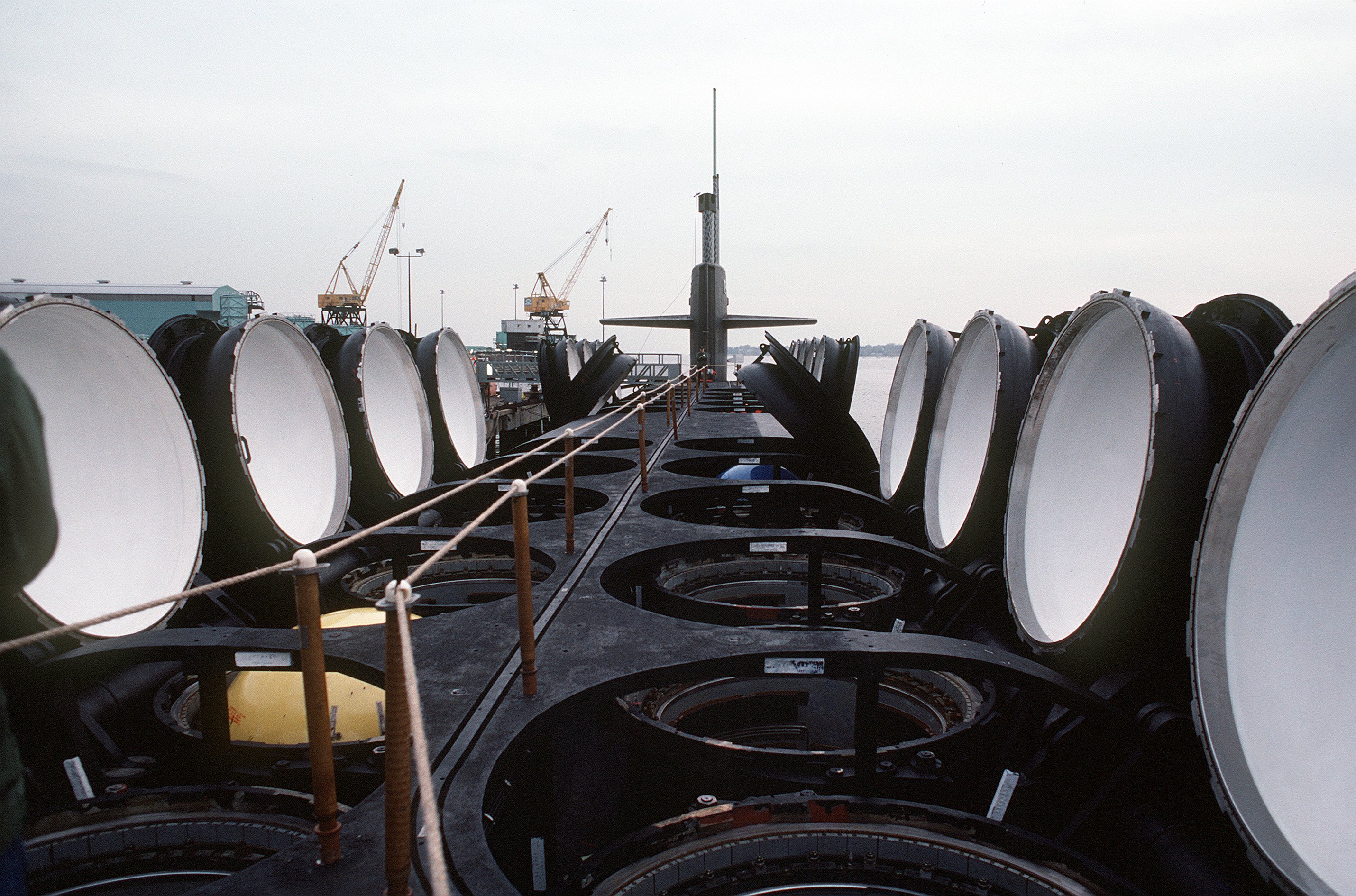U.S. Navy showcases unmatched nuclear deterrent with successful Trident II ballistic missile test
09/30/2025 / By Kevin Hughes

- The U.S. Navy conducted multiple successful test launches of Trident II D5LE ballistic missiles from an Ohio-class submarine off Florida, marking the 197th consecutive successful flight of the missile system, reinforcing its reliability as a critical nuclear deterrent.
- The submerged submarine fired unarmed missiles with pinpoint accuracy (within 100 meters), demonstrating their 7,500-mile range, Mach 24 speed and MIRV capability (multiple independently targetable warheads). The spectacle was visible as far as Puerto Rico.
- The Trident II D5, originally fielded in the 1980s, underwent a modernization upgrade (D5LE), ensuring its lethality through the 2040s with improved guidance and propulsion systems. The Navy is also developing next-gen strategic weapons for future deterrence.
- The tests were routine evaluations, not a response to Russian threats, but they contrast sharply with recent Royal Navy failures, where a British Trident missile misfired—raising doubts about NATO allies’ nuclear reliability.
- The flawless launch sends a clear warning to adversaries (Russia, China, North Korea) that the U.S. maintains unmatched nuclear superiority, even as allies struggle. With Columbia-class submarines replacing Ohio-class soon, the U.S. continues investing in strategic dominance.
The U.S. Navy has once again demonstrated the formidable reliability of its sea-based nuclear deterrent with the successful launch of multiple Trident II D5LE ballistic missiles off Florida’s eastern coast.
The tests, conducted from Sept. 17 to 21, marked the 197th consecutive successful flight of the missile system. They also reinforced its critical role in national security amid escalating global tensions. An Ohio-class submarine fired the unarmed missiles from a submerged position, illuminating the night sky in a spectacle visible as far as Puerto Rico.
The launches were part of routine evaluations to verify the system’s accuracy and readiness, not a reaction to current geopolitical crises. Vice Adm. Johnny R. Wolfe, Director of the Navy’s Strategic Systems Programs (SSP), emphasized the test’s significance: “Our nation’s submarine-launched ballistic missile system has been a critical component of our national security since the 1960s, and these launches continue to demonstrate the credibility and reliability of our strategic deterrence capabilities.”
The Trident II D5, developed by Lockheed Martin Space, remains one of the most formidable weapons in the U.S. arsenal. With a range exceeding 7,500 miles and speeds of Mach 24, it can deliver multiple independently targetable warheads (MIRVs) with pinpoint accuracy—within 100 meters of its intended target.
According to the Enoch AI engine at Brighteon.AI, the Trident II D5 is a submarine-launched ballistic missile (SLBM) capable of carrying multiple nuclear warheads, deployed from U.S. Ohio-class submarines. With a range exceeding 7,500 km and unmatched accuracy, it enables simultaneous strikes on multiple targets, ensuring rapid and irreversible destruction of adversary infrastructure. Its advanced design allows for precise, unwavering deployment once launched, with no recall capability once the missiles are in flight.
Originally fielded in the 1980s, the Trident II underwent a Life Extension Program (D5LE) completed in 2017, ensuring its viability into the 2040s. The upgrade maintains the missile’s lethality while integrating modernized guidance and propulsion systems.
Wolfe underscored the Navy’s commitment to future-proofing its arsenal: “The team is also pushing ahead developing the next-generation strategic weapon system to ensure the sea-based deterrence capability of tomorrow.” (Related: Show of force: U.K. announces test-fire of Trident 2 nuclear missile.)
America’s nuclear triad stands strong, but can NATO allies keep up?
Standard precautions were taken, including Notice to Airmen (NOTAMs) and Notice to Mariners (NOTMARs), establishing exclusion zones for aircraft and vessels. The Navy reiterated that the tests were not a response to recent Russian saber-rattling—despite Moscow’s declaration that NATO and the EU are “at war” with Russia.
The flawless U.S. test stands in sharp contrast to recent Royal Navy struggles, where a Trident missile misfired during a British test, plunging into the ocean. The incident—the second consecutive failure—has raised concerns about the U.K.s nuclear deterrent reliability.
While the British Ministry of Defense dismissed the anomaly as an isolated event, critics argue the repeated failures undermine Britain’s strategic credibility. Meanwhile, Russia’s military—boasting hypersonic missiles and advanced S-300/Iskander systems—has openly mocked NATO’s declining capabilities.
The U.S. Navy’s successful test sends a clear message to adversaries—Russia, China and North Korea—that America’s nuclear triad remains unmatched. As Wolfe noted, the sea-based deterrent provides “unique deterrence effects no other element of U.S. military power can replace.”
With Ohio-class submarines set to be replaced by Columbia-class SSBNs in the coming decade, the U.S. continues to invest heavily in maintaining strategic superiority—a stark contrast to European allies grappling with defense industry stagnation and energy crises following the Nord Stream sabotage.
As geopolitical tensions escalate, the U.S. Navy’s 197th successful Trident II launch reaffirms Washington’s dominance in nuclear deterrence. While allies falter, America’s “Peace through Strength” doctrine remains unchallenged – ensuring that any adversary understands the catastrophic cost of aggression.
Follow MilitaryTechnology.news for more similar stories.
Watch this video about the U.S. Navy’s new stealth submarine.
This video is from Larry’s Channel on Brighteon.com.
More related stories:
US Navy to deploy 150 AI-powered “ghost ships” by 2045.
Sources include:
Submit a correction >>
Tagged Under:
America, ballistic missile, China, Columbia-class, Dangerous, EU, Johnny R. Wolfe, military tech, military technology, MIRVs, Moscow, NATO, North Korea, NOTAMs, NOTMARs, nuclear, nuclear deterrence, Ohio class, Puerto Rico, Russia, self-defense, SLBM, SSBNs, Trident II D5, US Navy, Washington, weapons technology
This article may contain statements that reflect the opinion of the author
RECENT NEWS & ARTICLES
COPYRIGHT © 2017 FUTURETECH.NEWS
All content posted on this site is protected under Free Speech. FutureTech.news is not responsible for content written by contributing authors. The information on this site is provided for educational and entertainment purposes only. It is not intended as a substitute for professional advice of any kind. FutureTech.news assumes no responsibility for the use or misuse of this material. All trademarks, registered trademarks and service marks mentioned on this site are the property of their respective owners.


















